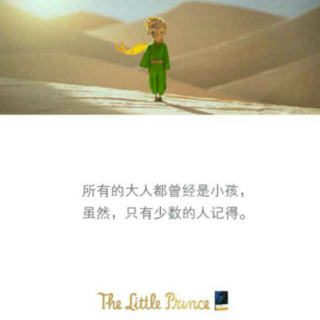
介绍:
As each day passed I would learn, in our talk, something about the little prince’s
planet, his departure from it, his journey. The information would come very
slowly, as it might chance to fall from his thoughts. It was in this way that I
heard, on the third day, about the catastrophe of the baobabs. This time, once more, I had the sheep to thank for it. For the little prince asked me abruptly–
as if seized by a grave doubt– “It is true, isn’t it, that sheep eat little bushes?”
“Yes, that is true.”
“Ah! I am glad!”
I did not understand why it was so important that sheep should eat little
bushes. But the little prince added:
“Then it follows that they also eat baobabs?” I pointed out to the little prince that baobabs were not little bushes, but,
on the contrary, trees as big as castles; and that even if he took a whole herd of elephants away with him, the herd would not eat up one single baobab.
The idea of the herd of elephants made the little prince laugh.
“We would have to put them one on top of the other,” he said.
But he made a wise comment:
“Before they grow so big, the baobabs start out by being little.”
“That is strictly correct,” I said. “But why do you want the sheep to eat
the little baobabs?” He answered me at once, “Oh, come, come!”, as if he were speaking of something that was self-evident. And I was obliged to make a great mental effort to solve this problem, without any assistance. Indeed, as I learned, there were on the planet where the little prince lived– as on all planets– good plants and bad plants. In consequence, there were good seeds from good plants, and bad seeds from bad plants. But seeds are invisible.They sleep deep in the heart of the earth’s darkness, until some one among
them is seized with the desire to awaken. Then this little seed will stretch itself
and begin– timidly at first– to push a charming little sprig inoffensively upward
toward the sun. If it is only a sprout of radish or the sprig of a rose-bush, one
would let it grow wherever it might wish. But when it is a bad plant, one must
destroy it as soon as possible, the very first instant that one recognizes it.
Now there were some terrible seeds on the planet that was the home of the
little prince; and these were the seeds of the baobab. The soil of that planet
was infested with them. A baobab is something you will never, never be able to
get rid of if you attend to it too late. It spreads over the entire planet. It bores
clear through it with its roots. And if the planet is too small, and the baobabs
are too many, they split it in pieces. . .
“It is a question of discipline,” the little prince said to me later on. “When
you’ve finished your own toilet in the morning, then it is time to attend to the
toilet of your planet, just so, with the greatest care. You must see to it that
you pull up regularly all the baobabs, at the very first moment when they can
be distinguished from the rosebushes which they resemble so closely in their
earliest youth. It is very tedious work,” the little prince added, “but very easy.”
And one day he said to me: “You ought to make a beautiful drawing, so
that the children where you live can see exactly how all this is. That would
be very useful to them if they were to travel some day. Sometimes,” he added,
“there is no harm in putting off a piece of work until another day. But when it is a matter of baobabs, that always means a catastrophe. I knew a planet that
was inhabited by a lazy man. He neglected three little bushes. . . ”
So, as the little prince described it to me, I have made a drawing of that
planet. I do not much like to take the tone of a moralist. But the danger of the baobabs is so little understood, and such considerable risks would be run by
anyone who might get lost on an asteroid, that for once I am breaking through
my reserve. “Children,” I say plainly, “watch out for the baobabs!”
My friends, like myself, have been skirting this danger for a long time, without
ever knowing it; and so it is for them that I have worked so hard over this
drawing. The lesson which I pass on by this means is worth all the trouble it
has cost me.
Perhaps you will ask me, “Why is there no other drawing in this book as
magnificent and impressive as this drawing of the baobabs?”
The reply is simple. I have tried. But with the others I have not been
successful. When I made the drawing of the baobabs I was carried beyond
myself by the inspiring force of urgent necessity.
每天我都了解到一些小王子的星球,他的出走和施行等事情。这些都是偶然从各种反应中慢慢得到的。就这样,第三天我就了解到关于猴面包树的悲剧。 这一次又是因为羊的事情,突然小王子好象是非常担心地问我道: “羊吃小灌木,这是真的吗?” “是的,是真的。” “啊,我真高兴。” 我不明白羊吃小灌木这件事为什么如此重要。可是小王子又说道: “因此,它们也吃猴面包树罗?” 我对小王子说,猴面包树可不是小灌木,而是象教学那么大的大树;即使是带回一群大象,也啃不了一棵猴面包树。 一群大象这种想法使小王子发笑: “那可得把这些大象一只叠一只地垒起来。” 他很有意识地说: “猴面包树在长大之前,开始也是小小的。” “不错。可是为什么你想叫你的羊去吃小猴面包树呢?” 他回答我道:“唉!这还用说!”似乎这是不言而喻的。可是我自己要费很大心劲才能弄懂这个问题。 原来,在小王子的星球上就象其它所有星球上一样,有好草和坏草;因此,也就有益草的草籽和毒草的草籽,可是草籽是看不见的。它们沉睡在泥土里,直到其中的一粒忽然想要苏醒过来…于是它就伸展开身子,开始腼腆地朝着太阳长出一棵秀丽可爱的小嫩苗。如果是小萝卜或是玫瑰就的嫩苗,就让它去自由地生长。如果是一棵坏苗,一旦被辨认出来,就应该马上把它拔掉。因为在小王子的星球上,有些非常可怕的种子…这就是猴面包树的种子。在那里的泥士里,这种种子多得成灾。而一棵猴面包树的树苗,假如你拔得太迟,就再也无法把它清除掉。它就会把整个星球搞得支离破碎。 “这是个纪律问题。”小王子后来向我解释道。“当你早上梳洗完毕后,必须仔细地给星球梳洗,必须规定自己按时去拔掉猴面包树苗。这种树苗小的时候与玫瑰苗差不多,一旦可以把它们区别开的时候,就要把它拔掉。这是一件非常乏味的工作,但很容易。” 有一天他劝我用心地画一副漂亮的图画,好叫我家乡的孩子们对这件事有一个深刻的印象。他还对我说:“如果将来有一天他们出外施行,这对他们是很有用的。有时候,人们把自己的工作推到以后去做,并没有什么妨害,但要遇到拔猴面包树苗这种事,那就非造成大灾难不可。我遇到过一个星球。上面住着一个懒家伙,他放过了三棵小树苗…” 于是,根据小王子的说明,我把这个星球画了下来。我从来不大愿意以道学家的口吻来说话,可是猴面包树的危险,大家都不大了解,对迷失在小行星上的人来说,危险性非常之大,因此这一回,我贸然打破了我的这种不喜欢教训的的惯例。我说:“孩子们,要当心那些猴面包树呀!”为了叫我的朋友们警惕这种危险——他们同我一样长期以来和这种危险接触,却没有意识到它的危险性——我花了很大的功夫画了这副画。我提出的这个教训意义是很重大的,花点功夫是很值得的。你们也许要问,为什么这本书中别的画都没有这副画那么壮观呢?回答很简单:别的画我也曾经试图画很好些,却没有成功。而当我画猴面包树时,有一种急切的心情在激励着我
大家还在听

